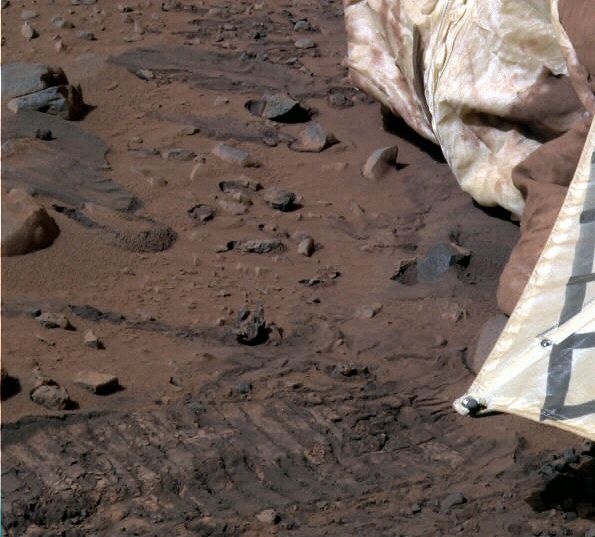Cydonia Quest The Occasional Journal C Entry No. 6 - 8th May 2004 A Mars Update This entry to the Occasional Journal is to update readers on further developments about issues mentioned in earlier entries - just in case readers did not catch all of the news stories. "Bunny Ears". The MER (Mars Exploration Rover) team have published an explanation of why they think "bunny ears" was a piece of fabric torn off the Opportunity lander's air bags. This conclusion is deduced largely from tangential evidence. Obviously, the most efficient and conclusive method of finding out what "bunny ears" was would have been if the MER team had taken a close-up look at it when the Opportunity rover was towering over it. Even if "bunny ears" was indeed a scrap of fabric from the airbags, the MER team's studied lack of interest in it is still strange. If the lander's airbags are getting shredded on landing then this should be of concern to them, because the robustness of the protective airbags is crucial to the safe landing of future NASA probes. The MER team's explanation of "bunny ears" can be read at the other end of this "stargate" µµµ. The Filament. The MER team have also produced a slide show explaining why they think the "filament" seen close-up by the Opportunity rover with its micro-imager is a fibre off the airbags. The appearance of the "filament" is indeed what one would expect from an artificial fibre. (See µµµ). Current Liquid Water in the Martian Soil. A number of MER, NASA and other space scientists have published a short description of how they think minute quantities of current, salty, liquid water have created the sticky nature of the soil at the Spirit rover landing site. This is in slow download PDF format and can be read here µµµ. Obviously the existence of any liquid water on Mars provides an environment for life.
|
| C ccccccccc C The Great Martian Fossil Hunt. As readers will be aware the MER team decided that sedimentary layers of rock found at the Opportunity rover landing site were almost certainly laid down by a sea or large lake. Indeed the Meridiani landing site was chosen exactly because of the suspicion that there had once been a large body of water there. This development was considered so important by NASA that they effectively announced the discovery twice at two big press conferences weeks apart. The first announcement was enough to make the Enterprise Mission and others publish articles on the internet drawing attention to possible fossils of life that could have lived in that large body of Martian water. (See µµµ & µµµ). Interestingly, at the second of the NASA press conferences, officials played up the possibility of the rover finding marine fossils at Meridiani. Even the ultra-cautious Stephen Squyres was happy to suggest that some evidence of past life may be found - worded in an ultra-cautious kind of way that avoided mention of the "F" word. (See µµµ & µµµ). "If you have an interest in searching for fossils on Mars, this is the first place you'd want to go." - Ed Weiler, NASA Associate Administrator for Space Science "The particular type of rock Opportunity is finding, with evaporate sediments from standing water, offers excellent capability for preserving evidence of any biochemical or biological material that may have been in the water." - Stephen Squyres, MER Principle Investigator. c New Signs of Life on Mars. The European Space Agency's (ESA) Mars Express spacecraft has detected significant quantities of methane in the Martian atmosphere (See µµµ). This discovery has been confirmed by two independent teams of astronomers on Earth. The lack of an ozone layer on Mars means that methane molecules rapidly breakdown in the Sun's ulta-violet light. Therefore the methane on Mars is being replenished from some unidentified source. On Earth methane is intricately linked with current or past biology. This final confirmation of methane on the Red Planet - (it had been detected by Mariner 7 in 1969, but the evidence was discounted) - is the first credible sign that Mars' atmosphere is being altered by current or past life. (The methane may be from a fossil source left behind by long dead organisms). Richard Hoagland has written a thoughtful and provocative three part article on this methane discovery that can be read here µµµ. As I finish this new entry to the Occasional Journal it seems that even more significant bio-marker gases than methane have been detected by the Mars Express spacecraft. It is now just a matter of confirming the findings before we can say for sure whether there is current life on Mars. (See µµµ). "Speculation is that already methane is a rather strong indicator life is probably present today on Mars. Just simply based on methane. ...Formaldehyde is destroyed in the Martian atmosphere within 7.5 hours. There is no way that formaldehyde can exist and remain for a long time in the Martian atmosphere. If (formaldehyde) confirmed, possibly life on Mars today, yes." - Vittorio Formisano, Ph.D., Physicist Principal Investigator of the Planetary Fourier Spectrometer for Mars Express. c µ Click this "Stargate" to return to Journal main page µ Return to the main Mars page
|
